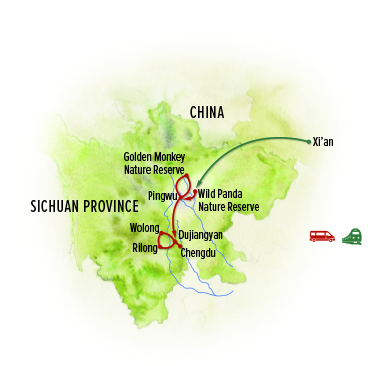2025 Itinerary
Arrive in the ancient imperial capital of Xi'an, one of China’s earliest regions to be settled, and transfer to our hotel in the Yanta District where we find a number of iconic cultural sites including the Wild Goose Pagodas. Xi’an is where China's first emperor united the disparate warring tribes of the vast realm in the 3rd century B.C. to launch one of the world’s most extraordinary civilizations. The capital of 13 dynasties, Xi’an’s walled city and narrow streets hark back to a time when it was a center for cultural, religious and economic interactions between East and West at the east end of the Silk Road traveled by Persian and Arab traders 1,300 years ago.
After lunch, we visit a portion of the ancient city wall. Xi'an is one of the few cities in China where the old city walls still stand, with most sections carefully restored or rebuilt. Constructed originally in 1370 during the Ming dynasty, the imposing 40-foot-high walls are surrounded by a dry moat and form a rectangle with an 8.6-mile perimeter. Atop the city walls, get a sweeping view over modern-day Xi'an. This evening, we gather for a delectable Chinese meal at our welcome dinner.
Day 2: Xi'an—Terracotta Army / Lesser Wild Goose Pagoda

Depart early this morning for Xi’an’s most famous sight, the Terracotta Warriors. Unearthed in 1974 in the suburbs outside the walled city, the stone army is one of the world's most remarkable archaeological discoveries. Consisting of 8,000 life-size soldiers, 130 chariots and more than 500 horses, none identical, the army was built to guard the massive mausoleum complex of Qin Shihuang (259–210 B.C.), the pivotal leader who became China’s first emperor. The figures vary in height according to their rank, the tallest being the generals. The majority of the figures remain in situ in the pits near the mausoleum, while other non-military terracotta figures were found in adjoining pits, including officials, acrobats, strongmen, and musicians. The Terracotta Army was discovered by a group of local farmers who were digging a well near the Qin Emperor's tomb mound in a region laced with underground springs. Subsequent excavation and research via ground-penetrating radar has revealed that the Army is part of a much larger necropolis covering 38 square miles, part of the emperor's imperial palace compound surrounding his tomb.
Next we continue to Lesser Wild Goose Pagoda, the smaller of two impressive towers built in Xi'an in the 8th century during the Tang dynasty. The site was inscribed on UNESCO's World Heritage List in 2014 as part of the Silk Roads Network. The well-preserved Buddhist temple is surrounded by a tranquil park and gardens, which we enjoy wandering through before returning to our hotel. After dinner, we head out to discover Xi'an after dark, with a chance to capture photos of the cityscape lit up at night.
Day 3: Qing Xi Village Visit / Wild Panda Nature Reserve
This morning, board the bullet train to Guangyuan, where we meet our bus and drive to the Wild Panda Nature Reserve. Along the way, we stop in the Muslim village of Qing Xi, with time to wander among scenes of relaxed street life amid the 300-year-old wooden buildings that date from the Qing dynasty. It's a peaceful setting, with a stream coursing through the center of the village. Just beyond the small town lies a secret slice of Chinese wilderness, a chain of nature reserves little known to outsiders and visited by a mere handful of Westerners. As we follow a rushing river up the narrow valley to our destination, keep an eye out for native wildlife. Eventually we arrive at our hotel, tucked away in the forest in a setting that's virtually unknown to tourists, where our nearest neighbors are mostly wild animals that thrive in these protected environs.
Day 4: Exploring the Wild Panda Nature Reserve with Exclusive Access
Our focus for two exciting days is a remote 100,000-acre sanctuary encompassing a densely forested ecosystem that is among the most diverse and intact in Asia. This national reserve, rated Grade I by WWF as a global biodiversity hotspot, is home to healthy populations of some of the world’s most endangered and vulnerable wildlife, including at least 60 giant pandas. Among its 430 different mammal species, the reserve also harbors more than 1,200 takin — a large, shaggy relative of wild sheep and goats — as well as more than 2,400 different kinds of plants. Look for wildlife on morning and evening excursions, stopping to enjoy stunning vistas of waterfalls, boulder-strewn gorges and mist-shrouded limestone peaks. This is prime panda habitat, and although sightings of this famously elusive animal are extremely rare, our exclusive permits allow us into remote areas of the reserve where they freely live and breed, affording us the best possible opportunity to spot signs of them in the wild. Even if we are highly unlikely to spy them in the heavy bamboo understory, just knowing that we’re in their midst is exhilarating.
Day 5: Wild Panda Nature Reserve / Pingwu
Spend another day searching for wildlife as we explore more of the reserve’s lush recesses. Within the sanctuary, we look for Tibetan and rhesus macaques, golden and Sichuan takin, musk deer, muntjac, serow, wild boar and blue sheep. More rarely, we may also see endangered moon bears and red pandas. Birding is superb, with more than 150 species in the reserve—the elegant golden pheasant is a prize. We can often observe all of these from the many remote roads and trails we explore, although dense vegetation and weather may affect our sightings. Late this afternoon, we depart the reserve and follow the scenic Fujiang River through the Min Mountains, returning to Qing Xi where we stop for an authentic local dinner. Afterward, we drive a short distance to Pingwu in far northwest Sichuan, our destination for the next two nights.
Day 6: Golden Monkey Nature Reserve
This morning we enter the forested nature reserve home to golden snub-nosed monkeys that live in the shadow of Sichuan's tallest mountain. We walk uphill for about 30 minutes on a trail leading into the nature reserve where the monkeys reside, with rest stops en route. The reserve covers 62 square miles of wild terrain filled with alpine forest, waterfalls, lakes, colorful karst formations, glacial rivers and an abundance of animal life. We expect to get excellent sightings of endangered golden monkeys, which have been habituated to humans and are unfazed by our presence. The monkeys live in highly social bands, and their interactions delight us. Covered with a mantle of long, shaggy fur, they are hardy creatures, tolerating winter snow and colder temperatures better than any other non-human primate. On our return journey to Pingwu, we drive through territory home to Baima Tibetans, the descendants of Tibetan soldiers sent here more than 1,300 years ago to conquer the frontier. Keep an eye out for hats sporting white rooster feathers worn only by this group of Tibetan women.
Day 7: Scenic Drive to Dujiangyan
A spectacular mountain road journey is in store as we make the full-day journey south to Dujiangyan. As we travel through this mountainous region, we pause periodically along our route to admire dramatic landscapes, rural villages and Buddhist temples. Along our path, we pass through Mianyang, known as Fujun in ancient times, with a 2,200-year history that spans the Qin and Han dynasties. We also stop to visit a local market in Jiangyou that gives us a taste of small-town life and showcases the bounty of fruit and vegetables that are harvested locally in the Sichuan Basin. Enjoy a traditional dinner this evening, then rest in Dujiangyan at an elegant new resort hotel.
Day 8: Dujiangyan Panda Base & Dujiangyan Panda Valley
Today provides chances for close-up views of China’s beloved giant pandas on a visit to two panda facilities in Dujiangyan. Opened in 2013 with the arrival of 10 pandas, Dujiangyan Panda Base focuses on rescue, disease control and prevention, and rehabilitation of injured and ill wild pandas. It has expanded its mission, and its numbers, to encompass care for senior and disabled pandas as well as healthy pandas that are part of the preventive research program. We dedicate a portion of our time here to volunteer in the care of the pandas, though this opportunity is not guaranteed and depends on the status of the pandas at the time of our visit. Conditions permitting, we enjoy a behind-the-scenes look at caring for pandas and may have the chance to assist their keepers with tasks such as preparing their food.
After lunch, we visit Dujiangyan Panda Valley. This is a newer facility that is both a panda research and breeding base and a center for conservation education. In natural environs, pandas are gradually habituated and returned to the wild. Reintroduction training experts from around the globe gather here for collaborative research. This quiet research base is landscaped with beautiful flowers and we may see pandas in transitional “dens” that are learning to live on their own in the natural surroundings. We're likely to see many red pandas here as well.
Day 9: Gengda Wolong Panda Base / Rilong
Setting out from Dujiangyan, we head for the newly rebuilt Gengda Wolong Panda Center in the Wolong Nature Reserve, a base that integrates scientific research, captive breeding and reintroduction of pandas into the wild. More than 30 pandas reside at the center, which includes a 680-acre bamboo forest. Get close-up photos of giant pandas in this natural habitat that features a striking mountain backdrop. Traveling west, we continue to Rilong, a Tibetan village known famously as a base camp for climbing 20,505-foot Mount Siguniang. Translating to Four Sisters Mountain, this imposing massif encompasses four separate peaks, Daguniangshan, Erguniangshan, Sanfeng and Yaomeifeng, and is often referred to as the “Chinese Alps.” In Rilong we are immersed in Tibetan culture, with traditional architecture on display and yak butter tea for sale by local vendors. This high-altitude village, which sits over 10,000 feet above sea level, is the center of the Jiarong Tibetan culture, found only in this region of Sichuan province. The rural Jiarong people are known for their intricately embroidered costumes and agricultural lifestyle.
Day 10: Siguniangshan National Park
Early risers may catch the sunrise behind the peaks in Rilong, a vista acclaimed for its singular beauty. We spend the full day exploring the dramatic scenery of nearby Siguniangshan National Park. Entering the 25-mile-long Shuangqiao Valley, we view snowcapped peaks in every direction, with Four Sisters Mountain towering above. The valley floor is 10,000 feet above sea level, and the highest mountains nearly double that. Explore the colorful geological features and mirror-like lakes of this subalpine terrain, following boardwalk trails that weave among occasional pagodas and prayer flags. Highlights include the Yin-Yang Valley, Willow Bridge, Sun-Moon Mirror Mountain and Five-Colored Mountain with its rocks that glow red, yellow, green, blue and white. These high-altitude forests are native habitat for the endangered red panda, too. Deeper into the valley, we reach the Ginsenguo flatland, with a viewing deck overlooking highland swamps and snowy peaks, and Jiujia Lake, which is actually a group of four seasonal lakes and nine perennial ones—the legendary bathing pools for the “four sisters.”
Day 11: Chengdu—Bian Lian "Sichuan Face Changing" Show
Today we make a relaxed full-day drive back to Chengdu, spending the night at a hotel near the international airport for convenient departures tomorrow morning. At this evening's festive farewell dinner, enjoy a demonstration of Bian Lian, or "Sichuan face changing," a mesmerizing opera element where performers rapidly switch colorful masks to portray different characters and emotions. Only about 200 people practice this secretive art form that can entail changing up to 10 masks in less than 20 seconds, and we marvel at the mystery and the mastery as we reflect on the adventures we've shared.
Day 12: Chengdu / Depart
After a sumptuous buffet breakfast at our luxury hotel next to the airport, transfer the short distance to meet departing flights.



























